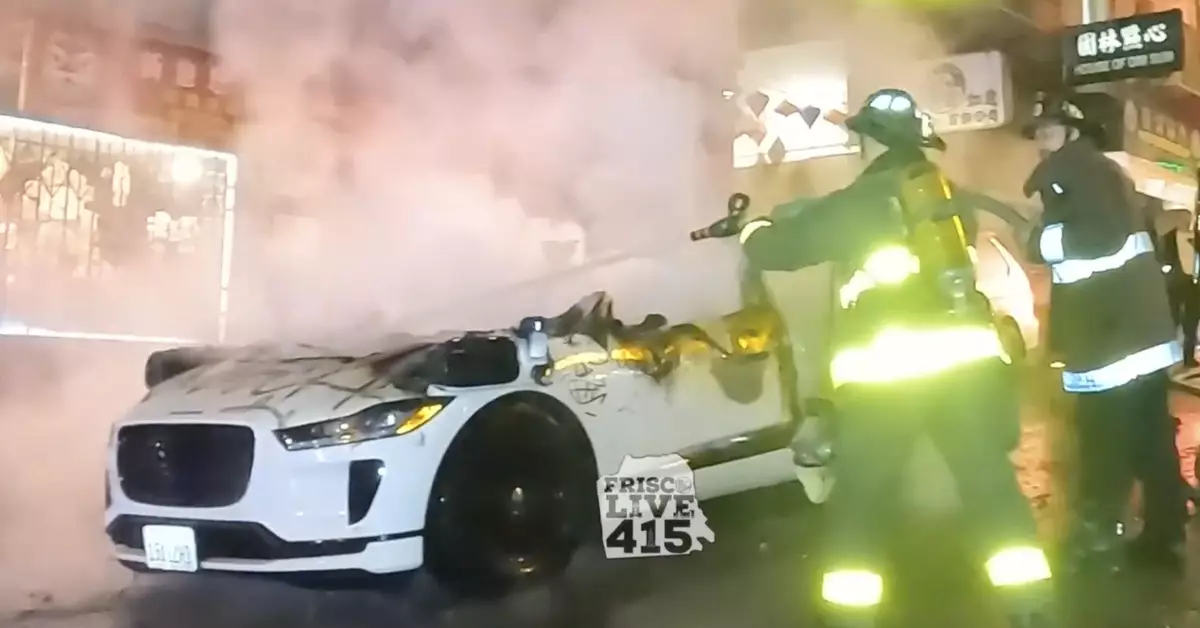The increasing integration of technology in our daily lives has led to both admiration and disdain. The recent incident in San Francisco’s Chinatown, where a Waymo driverless taxi was attacked and set on fire, highlights the ongoing tension between the general public and autonomous vehicles. This article delves into the details of the incident and explores the broader issue of vandalism and defacement faced by tech companies.
Late in the evening, a person jumped onto the hood of a Waymo driverless taxi and proceeded to smash its windshield. The audacity of the act was met with applause from onlookers, creating a morbid spectacle. The situation quickly escalated as a crowd formed around the car, covering it in spray paint, breaking its windows, and ultimately setting it on fire. Despite the prompt arrival of the fire department, it was too late to save the vehicle, as the flames had already fully engulfed it.
So far, no clear motive for the attack has been established. It remains unclear what drove the individual to carry out such an act of destruction. The Waymo representative confirmed that the car was not carrying any passengers at the time of the incident. However, the attacker resorted to tossing fireworks inside the vehicle, which sparked the flames that eventually consumed it. Thankfully, there were no reports of injuries during this shocking incident.
Tensions between Residents and Automated Vehicles
This act of vandalism takes place against the backdrop of growing tension between San Francisco residents and autonomous vehicle operators. Last year, the California Department of Motor Vehicles suspended the operations of Cruise, a Waymo rival, after one of its cars struck and dragged a pedestrian. Additionally, automated taxis have caused chaos in the city in the past, blocking traffic and even crashing into a fire truck. Recently, another Waymo vehicle collided with a cyclist, further fueling the concerns of city officials and residents.
Public Opposition and Protests
Residents of San Francisco have made their opposition to autonomous vehicles clear. Last year, when the cars were given a license for 24/7 operation, many residents vehemently protested. In an act of civil disobedience, they immobilized the vehicles by placing orange cones on their hoods. This display of public dissatisfaction with the integration of autonomous vehicles into everyday life signals a deeper conflict between technological progress and the desires of the community.
Reflecting on Vandalism
Vandalism and defacement are unfortunate realities that accompany the progress of society. Throughout history, we have witnessed acts of destruction, from subway cars in New York City to the walls of the ancient city of Pompeii. Tech companies, in particular, have begun to confront this unfortunate inevitability as they deploy their equipment in public spaces. From scooters being tossed into lakes to cars being punched by pedestrians, the manifestation of frustration towards technology is evident.
The Way Forward
As technology continues to advance, it is crucial for tech companies and communities to find common ground. Striking a balance between progress and public sentiment is paramount. Companies like Waymo must actively engage with the concerns of residents and work towards tangible solutions that address security, safety, and accountability. Additionally, educating the public about the benefits and limitations of autonomous vehicles can help bridge the gap and foster a more harmonious relationship between technology and society.
The attack on the Waymo driverless taxi in San Francisco’s Chinatown serves as a stark reminder of the tensions that arise when new technologies are introduced. We must recognize that progress inevitably faces resistance, and it is our collective responsibility to navigate this transition with empathy and understanding. By addressing public concerns and working towards effective solutions, we can create a future where technology and society coexist in harmony.


Leave a Reply